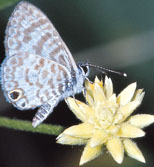 More
than Meets the Eye
More
than Meets the Eye
The University Of Florida Is A Leading Center For Butterfly Research And Conservation
By Aaron Hoover
They appear to live in harmony, but the longwing butterflies dancing around passion vines in a University of Florida greenhouse are actually locked in a kind of evolutionary arms race.
The insects lay eggs on the vine and the emerging caterpillars devour
its leaves. In response, the vine has evolved to emit a poison that contains
cyanide. The caterpillars, in turn, have built up immunity to the poison. 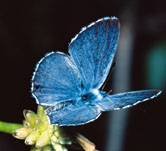
The standoff extends beyond chemical weapons. The butterflies like to lay eggs on the passion vine’s new shoots, usually a deep green. Sometimes, the shoots are camouflaged purple. As if to further impede the butterfly, the shape of the new leaves may change.
Long celebrated for their beauty, butterflies are increasingly being recognized for their central role in natural science. The "co-evolution" of the Longwing and the passion vine is a striking example of a wider natural phenomenon, while the butterfly’s ability to flourish despite the plant’s poison may have implications for human health. UF entomology doctoral student Mirian Medina Hay-Roe’s research into the Longwing-passion vine relationship is just one of dozens of butterfly research projects under way at UF. Scientists and students in a variety of disciplines probe butterfly development and evolution, map butterfly migration patterns and study butterfly diets, often with results extending well beyond butterflies. UF researchers also pursue related butterfly conservation projects in Florida, South America, Africa and elsewhere.
Lincoln Brower, a professor emeritus of zoology, and Bruce MacFadden, curator and associate director of the Florida Museum of Natural History, first brought UF to prominence in the science of butterfly migrations in the 1980s with their discovery that Monarch butterfly wings contain magnetic particles that help the insect use the Earth’s magnetic field to navigate. More recently, UF zoology and entomology Professor Tom Emmel is credited with saving the Schaus Swallowtail, a rare butterfly native to the Florida Keys, through a unique captive-breeding program.
"There are all kinds of mysteries, but we’re solving our share," says Emmel, adding that UF’s track record and the breadth of its research make it a world center for butterfly research.
Saving the Schaus
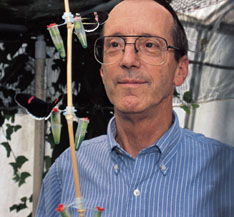 Like the Key Deer,
the Schaus Swallow- tail seems particularly well suited to the Florida
Keys, with its small size and delicate markings making it somehow more
fitting for the tiny island chain than its larger mainland cousin, the
Giant Swallowtail. But for Emmel’s work, however, the only chance to see
the butterfly would likely be as a preserved specimen in a glass museum
case.
Like the Key Deer,
the Schaus Swallow- tail seems particularly well suited to the Florida
Keys, with its small size and delicate markings making it somehow more
fitting for the tiny island chain than its larger mainland cousin, the
Giant Swallowtail. But for Emmel’s work, however, the only chance to see
the butterfly would likely be as a preserved specimen in a glass museum
case.
On a visit to the Keys in 1984, Emmel counted only 70 adult Schaus, findings he used to convince the federal government to make the butterfly one of the first insects protected under the Endangered Species Act. His research traced the butterflies’ plight in part to two pesticides used to combat mosquitos, Dibrom and Baytex. These findings spurred an end to the use of Baytex and stringent regulation of Dibrom.
The project also was blessed with a remarkable bit of luck. In June 1992, Emmel began a breeding colony of Schaus in Gainesville with 100 eggs collected from the butterflies’ native habitat. Two months later, Hurricane Andrew swept through South Florida, leaving only 17 remaining Schaus in the wild — all of them males. Emmel used his breeding colony to reintroduce the butterfly to the Keys from 1995-1997.
"At the time, our Schaus colony was the only such effort in the world to captively propagate endangered invertebrate species," Emmel recalls. "And to restore an invertebrate species in the wild was very, very unusual."
 |
 |
 |
 |
"We found that incidents of MS (multiple sclerosis) and similar neuromuscular disorders in Monroe County were 47 times the national average," he says. "Considering we were spraying Monroe County more than any other county, that was a pretty interesting correlation."
The findings, now being studied by other researchers, illustrate something crucial about butterflies: they often play a pivotal role in broader science and conservation efforts.
Unlike many animals, butterflies often adapt extremely rapidly to changes in their habitat or the environment. For instance, in a classic example of adaptation, the wings of a moth in England darkened as a result of industrial air pollution early in the 20th century, then lightened again in the 1980s following adoption of pollution control measures. At the heart of this remarkable ability to transform quickly are chromosomes that can split apart and recombine easily. This property is proving vital to scientists studying the genetics behind biological development. It may also provide new insights into genetic engineering.
"You can view butterfly wing pattern development as an index for how genes turn on and off at different stages of development," Emmel says. "With butterfly wings, you can see everything — you don’t have to do an in vitro culture of an embryo."
In conservation, butterfly diversity is usually an excellent indicator of an area’s overall plant and animal diversity. As a result, a butterfly census can help scientists and policy makers determine where to focus conservation efforts. UF doctoral students Jason Hall and Keith Willmott are inventorying the butterflies of Ecuador and identifying natural areas where butterfly diversity is concentrated. To date, they’ve catalogued 2,400 species, including 190 new ones. This data will be given to the Ecuadorian government for use in determining which areas should be protected.
"More and more government conservation departments around the world are realizing that butterflies are biodiversity indices," Emmel says, noting that similar efforts have occurred in Kenya and other countries. "They’re contracting with lepidopterists to do inventories and tell them what’s there so they, in turn, can use very simple statistical procedures to estimate how many bird species will be there, mammals and so forth."
Massive Migrations
While scientists agree that most butterfly species in the United States have been identified, much remains to be learned about their behavior and biology. One intriguing area of inquiry is butterfly migration. Although Monarch migration has been studied extensively, UF entomology Professor Thomas Walker is one of the first researchers to gather quantitative data that demonstrates migratory patterns in other butterflies. His focus is on four species that migrate in and out of Florida: the Gulf Fritillary, the Cloudless Sulfur, the Longtailed Skipper and the Buckeye.
Walker, an expert in "acoustic insects" like katydids and crickets, began studying butterfly migration after noticing that they always seemed to appear in the fall and spring, traveling, like birds, in southerly and northerly directions. So focused were the butterflies, Walker noted, that they flew over his house, not around it. At football games, he even noticed them over UF’s Ben Hill Griffin Stadium.
"It didn’t take very much observation to decide these butterflies were going somewhere instead of just flying," Walker says.
To confirm his observations, Walker devised traps that would capture southbound and northbound butterflies in different containers. The traps showed Walker was correct, with the butterflies’ fall migrations proving particularly consistent. Between 1984 and 2000, 93 percent of the more than 15,000 Cloudless Sulfurs captured in the fall were heading south. The same traps also captured 96 percent of Gulf Fritillaries, 84 percent of Buckeyes and 94 percent of Longtailed Skippers during the fall migrations.
During the course of his research, Walker also noted a disturbing decline in the number of migrating butterflies. His captures of the Cloudless Sulfur, Gulf Fritillary and Longtailed Skipper have declined steadily since 1986. For example, he captured about 400 Longtailed Skippers in 1986 and almost none in 1999.
Walker is somewhat mystified about the cause, saying it could be related to a change in crops cultivated in southern Georgia as well as the increased use of herbicides that wipe out plants on which the butterflies feed.
"I’m saddened because I think it’s such a neat phenomenon, but I don’t think people are going to stop using herbicides because it might damage butterflies," he says.
Feeding (And Protecting) Butterflies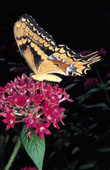
Habitat destruction is a major threat to butterflies worldwide. In one study of Florida butterflies, Emmel estimated that 60 of the state’s 180 native species are at risk, many due to the loss of their native lands and plants.
"In North Florida, most natural habitats are being cleared for pulp wood forests," he says. "In Central Florida, it’s citrus groves or home developments."
Stepped-up habitat protection is the best line of defense for butterflies, Emmel and other scientists agree, but other strategies may also help. One is to capitalize on surging public interest in butterflies, Emmel says. With butterfly watching and butterfly gardening on the upswing, researchers must strive to get out their conservation message.
"I urge every one of my graduate students to be prepared to get down into the trenches with the amateurs, with the garden clubs, with the Audubon Society, with the Sierra Club, and stress the message that we need to save what we can while we can," Emmel says.
One of the limitations to studying and protecting butterflies is that they are very picky eaters. Researchers and butterfly farmers, who raise butterflies for display or collectors, often have to provide specific, non-native host plants for each species.
To address this limitation, UF entomology Professor Jim Nation is trying to develop an artificial diet for butterflies.
Scientists have developed a wide range of synthetic diets for pest moths and beetles, but few have studied butterfly eating habits. Nation and his graduate students have been trying to come up with artificial diets for common butterflies including the Checkered White, which eats several plants but prefers Pepper Grass, and the Monarch, which eats only Milkweed. So far, they’ve tested five different artificial diets on caterpillars. Nation says the challenge is not the nutritional ingredients — ranging from egg albumen (protein) to wheat germ (vitamins) to vegetable oil (fats) — but rather making the diet tasty.
Nation has yet to rear a caterpillar to winged maturity on an artificial diet, but he has made progress. He’s learned that certain host plant extracts make the diet more attractive to the butterflies, and he’s learned that the shape of a butterfly meal plays a role. With most insect diets, the powder ingredients are mixed with heated agar, which gels when it cools. Nation’s research shows caterpillars eat more agar when it coats small pieces of paper that mimic the shape and structure of leaves.
"If we continue to develop habitat and destroy habitat, then obviously
we’re going to have fewer and fewer host plants available, so an artificial
diet could help save an endangered population," Nation says. "But the best
way for us to preserve butterflies is to preserve habitat."
| Tom Emmel
Professor and Director Division of Lepidoptera Research (352)392-5894 tcemmel@ufl.edu |
Jim Nation
Professor, Department of Entomology and Nematology (352) 392-1901 (ext. 146) jln@gnv.ifas.ufl.edu |
Thomas Walker
Professor, Department of Entomology and Nematology (352)392-1901 (ext. 125) tjw@gnv.ifas.ufl.edu |
 For Butterflies,
A Shared Passion
For Butterflies,
A Shared Passion
As a career scientist who has devoted much of his work to butterflies in Florida, UF zoology and entomology Professor Tom Emmel knows the state’s native species intimately. So when Gainesville attorney Dan White dropped by his office one day last spring to report seeing an orange butterfly with curious points on its wings, Emmel was intrigued.
He and White, an avid butterfly gardener who spotted the insect while out house hunting, identified the butterfly as a Daggerwing, a species common in South America and seen occasionally in South Florida but never in more northern locales.
"It’s an important new state record: a Daggerwing several hundred miles north of its accepted range," Emmel says. "With the drought and the strong southeasterly winds, I can explain why it might be here, but without Mr. White’s observation we would never know that it actually reached Gainesville."
Emmel, author of 357 papers and 35 books about butterflies and ecology, has tracked down rare butterflies in some of the world’s most remote regions and probed the intricacies of butterfly chromosomes under powerful microscopes. But he traces some of the biggest thrills in his 30-year-plus career to interactions with enthusiasts like White who have little to no formal training. In lepidopterology, as butterfly and moth science is known, Emmel is no exception. While many other sciences today are too technical for amateurs to play a key role, lepidopterology remains heavily reliant on people whose love for the subject outshines their academic credentials. The result is an increasingly rare culture of citizen science, one that sees professional scientists and hobbyist laymen cooperating to advance understanding and protection of some of the most beautiful creatures in the insect world.
The Collectors
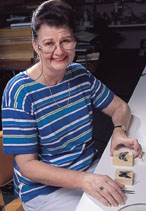
Jeffery Slotten, a dentist in the small town of Palatka in north-central
Florida, devotes his evenings and weekends to butterflies and moths. He
travels around the country hunting specimens. He has reared hundreds of
caterpillars into butterflies. And he has converted one of his bedrooms
into a kind of private butterfly museum, with thousands of specimens pinned
neatly to the bottom of wooden drawers carefully crafted to ensure they
remain airtight and safe from pests.
 "It’s very costly,"
he says. "But it’s also enjoyable in terms of what you can achieve."
"It’s very costly,"
he says. "But it’s also enjoyable in terms of what you can achieve."
Slotten is not alone. From its beginnings dating at least as far back as the 15th century, finding and collecting butterflies has proved a powerful passion. Nowhere is this more evident than at UF’s Allyn Museum of Entomology in Sarasota, part of the Florida Museum of Natural History. With more than 1 million specimens comprising 90 percent of the world’s species, the collection is the second largest in North America. As the repository of more than 100 private collections, some dating to the 1860s, it is a kind of memorial to the world’s butterfly collectors.
F. Martin Brown, co-founder of Pan American Airlines and a geologist by trade, scoured Ecuador and the Caribbean for butterflies in the 1920s. His collection is housed at the Allyn Museum. It is joined by 65,000 specimens assembled by Raymond Jae, an assembly line worker at a tire plant in Denver who conducted his hobby through extensive contacts with missionaries and other world travelers. Also represented are butterflies collected by a British ambassador to the Ivory Coast, a professional classical musician, a university dean, a Catholic priest posted to Ghana and a Navy SEAL who assembled his collection while on assignment in foreign locales.
The museum owes its very existence to an amateur collector. Arthur Allyn, a wealthy businessman who once owned the Chicago White Sox, began collecting butterflies at age 5. When he donated his collection to the University of Florida decades later in 1981, it contained 800,000 specimens, most from other collections he acquired. Allyn died at age 72 in 1985. The husband-and-wife curating team who oversaw his collection, Lee and Jacqueline Miller, continue their work today as curators of the museum.
For people susceptible to their charms, butterflies can be narcotic.
"I think initially it’s aesthetic, and then collectors are drawn into it by trying to determine and identify species," Jacqueline Miller says. "Then they notice some of the biological things that are different, some of the flight paths and behavior, and then they get intrigued with the larvae and some of the plant food associations. And then they’re hooked."
 Nabokov’s
Contribution
Nabokov’s
Contribution
Adonis blue
(Lycaena dispar)
A row of gray compacting shelves greets visitors to the main collection room in the museum, a well-hidden white stucco building adjacent to the Sarasota Jungle Gardens nature attraction. The nondescript shelves belie their colorful contents. Some 11,000 drawers contain an astonishing array of specimens, from the sparrow-sized Ornithoptera alexandra from New Guinea to the South African sapphire-like Poecilmitis to the fluorescent green Ornithoptera priamus from Australia. Among the specimens are extremely rare or extinct butterflies, such as the bluish Deudorix cleora, the only one of its type ever found – by an amateur visiting the island of Sulawesi in Indonesia on his honeymoon in 1938. The collection contains 25,000 specimens of Swallowtails alone.
With drawer after drawer opening to reveal spectacular butterflies, it would be easy to miss the Blues, a group of small butterflies with rounded wings that, despite their name, come in a range of colors. Blues were the singular passion of perhaps the world’s most famous amateur lepidopterist: Vladimir Nabokov. The author, whose Lolita was recently chosen one of the top 10 books of the 20th century, collected Blues, but he also studied the group and wrote several articles about the insects in scientific journals. Precise and scientific, the articles are also unmistakably Nabokovian. In one, titled "The Female of Lycaeides Argyrognomon Sublivens," Nabokov describes the weather in Telluride, Colo., where he spent part of the summer of 1951 on a collecting trip.
"Every morning the sky would be of an impeccable blue at 6 a.m. when I set out. The first innocent cloudlet would scud across at 7:30 a.m. Bigger fellows with darker bellies would start tampering with the sun around 9 a.m."
Such embellishments may have contributed to the mixed reception Nabokov’s work received in the scientific community. A 1999 book about his studies, Nabokov’s Blues, recounts how some of the author’s contemporaries criticized his findings as incomplete, off the mark, or both. The result: Nabokov’s work fell into scientific obscurity. In the 1990s, however, while doing research for a book on butterflies of the Caribbean and the West Indies, the Millers discovered that some of Nabokov’s findings were right on. The Butterflies of the West Indies and South Florida cites Nabokov as one of many authorities.
"He produced a higher classification of some of the Blues of the Lesser Antilles based on very limited material," Jacqueline Miller says. "When we went down there and did extensive field collection, we found information that supported his original theory."
Other amateurs are credited with some of the most important discoveries in the field, including such achievements as finding the Monarchs’ famed wintering site in Mexico. Amateurs have also added immeasurably to the bulk of knowledge about individual species and the range and habitats of different groups of butterflies, the Millers say.
Emmel notes that 16 of the 23 authors in a 1998 book he edited, Systematics of Western North American Butterflies, were authored by amateurs.
"The 74 papers represented in this volume represent incredible range
extensions, new species accounts, new races described and new life histories,"
Emmel says.
| Lee Miller, Curator
Allyn Museum of Entomology (941) 355-8476 |
Jacqueline Miller, Associate Curator
Allyn Museum of Entomology (941) 355-8476 jmiller@virtu.sar.usf.edu |
http://www.flmnh.ufl.edu/natsci/allyn/allyn_museum.htm